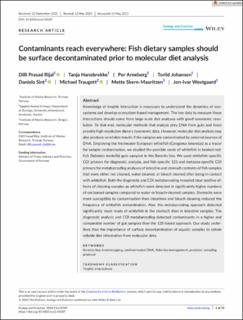| dc.contributor.author | Rijal, Dilli Prasad | |
| dc.contributor.author | Hanebrekke, Tanja Lexau | |
| dc.contributor.author | Arneberg, Per | |
| dc.contributor.author | Johansen, Torild | |
| dc.contributor.author | Sint, Daniela | |
| dc.contributor.author | Traugott, Michael | |
| dc.contributor.author | Skern-Mauritzen, Mette | |
| dc.contributor.author | Westgaard, Jon-Ivar | |
| dc.date.accessioned | 2023-10-02T13:25:52Z | |
| dc.date.available | 2023-10-02T13:25:52Z | |
| dc.date.created | 2023-08-24T09:59:39Z | |
| dc.date.issued | 2023 | |
| dc.identifier.citation | Ecology and Evolution. 2023, 13 (6), . | en_US |
| dc.identifier.issn | 2045-7758 | |
| dc.identifier.uri | https://hdl.handle.net/11250/3093506 | |
| dc.description.abstract | Knowledge of trophic interaction is necessary to understand the dynamics of ecosystems and develop ecosystem-based management. The key data to measure these interactions should come from large-scale diet analyses with good taxonomic resolution. To that end, molecular methods that analyze prey DNA from guts and feces provide high-resolution dietary taxonomic data. However, molecular diet analysis may also produce unreliable results if the samples are contaminated by external sources of DNA. Employing the freshwater European whitefish (Coregonus lavaretus) as a tracer for sample contamination, we studied the possible route of whitefish in beaked redfish (Sebastes mentella) guts sampled in the Barents Sea. We used whitefish-specific COI primers for diagnostic analysis, and fish-specific 12S and metazoa-specific COI primers for metabarcoding analyses of intestine and stomach contents of fish samples that were either not cleaned, water cleaned, or bleach cleaned after being in contact with whitefish. Both the diagnostic and COI metabarcoding revealed clear positive effects of cleaning samples as whitefish were detected in significantly higher numbers of uncleaned samples compared to water or bleach-cleaned samples. Stomachs were more susceptible to contamination than intestines and bleach cleaning reduced the frequency of whitefish contamination. Also, the metabarcoding approach detected significantly more reads of whitefish in the stomach than in intestine samples. The diagnostic analysis and COI metabarcoding detected contaminants in a higher and comparable number of gut samples than the 12S-based approach. Our study underlines thus the importance of surface decontamination of aquatic samples to obtain reliable diet information from molecular data. | en_US |
| dc.language.iso | eng | en_US |
| dc.title | Contaminants reach everywhere: Fish dietary samples should be surface decontaminated prior to molecular diet analysis | en_US |
| dc.title.alternative | Contaminants reach everywhere: Fish dietary samples should be surface decontaminated prior to molecular diet analysis | en_US |
| dc.type | Peer reviewed | en_US |
| dc.type | Journal article | en_US |
| dc.description.version | publishedVersion | en_US |
| dc.source.pagenumber | 15 | en_US |
| dc.source.volume | 13 | en_US |
| dc.source.journal | Ecology and Evolution | en_US |
| dc.source.issue | 6 | en_US |
| dc.identifier.doi | 10.1002/ece3.10187 | |
| dc.identifier.cristin | 2169243 | |
| cristin.ispublished | true | |
| cristin.fulltext | original | |
| cristin.qualitycode | 1 | |
